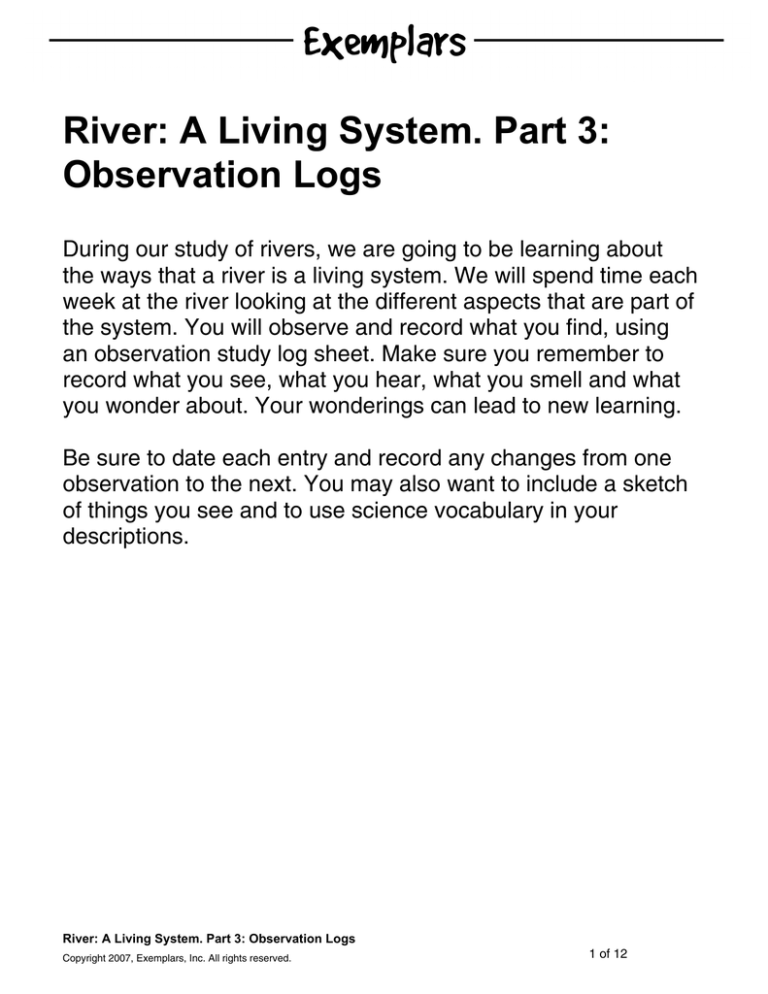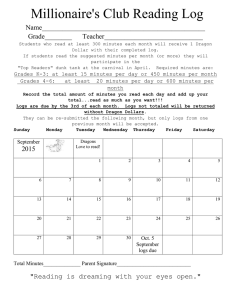
River: A Living System. Part 3:
Observation Logs
During our study of rivers, we are going to be learning about
the ways that a river is a living system. We will spend time each
week at the river looking at the different aspects that are part of
the system. You will observe and record what you find, using
an observation study log sheet. Make sure you remember to
record what you see, what you hear, what you smell and what
you wonder about. Your wonderings can lead to new learning.
Be sure to date each entry and record any changes from one
observation to the next. You may also want to include a sketch
of things you see and to use science vocabulary in your
descriptions.
River: A Living System. Part 3: Observation Logs
Copyright 2007, Exemplars, Inc. All rights reserved.
1 of 12
River: A Living System. Part 3: Observation Logs
Suggested Grade Span
3–5
Task
During our study of rivers, we are going to be learning about the ways that a river is a living
system. We will spend time each week at the river looking at the different aspects that are part
of the system. You will observe and record what you find, using an observation study log sheet.
Make sure you remember to record what you see, what you hear, what you smell and what you
wonder about. Your wonderings can lead to new learning.
Be sure to date each entry and record any changes from one observation to the next. You may
also want to include a sketch of things you see and to use science vocabulary in your
descriptions.
Big Ideas and Unifying Concepts
Cause and effect
Change and constancy
Interdependence
Patterns
Systems
Life Science Concepts
Evolution, diversity and adaptations
Structure and function
Earth and Space Science Concept
Earth structure and system
Science in Personal and Societal Perspectives Concept
Populations, resources and environments
River: A Living System. Part 3: Observation Logs
Copyright 2007, Exemplars, Inc. All rights reserved.
2 of 12
Mathematics Concepts
Data collection, organization and analysis
Graphs, tables and representations
Measurement
Scale
Time Required for the Task
The entire river unit took four to six weeks, during which weekly observation logs were
completed. Each observation entry took place during a class session of about 60 minutes.
Context
The observation log is an ongoing part of a river study unit that took place over four to six
weeks. Weekly trips to our local Thatcher Brook for observation and field studies, followed by
classroom lessons on different aspects of the river system, guided the observation process and
introduced new science vocabulary and concepts. Students kept observation logs, dating each
entry when we visited the brook. At the end of the study, students were able to self-evaluate
their growth in observation skills, using the observation rubric introduced in Part 1, by reviewing
their log entries. Observation logs became part of each student’s river study portfolio.
What the Task Accomplishes
Ongoing observation logs teach, reinforce and assess the skills of observation, recording data,
and communication. Students use their earlier observations and peer feedback to learn how to
improve their recording of what they see.
How the Student Will Investigate
During each trip to the river, students were asked to record observations using study log
sheets. Each student had a log sheet, a clipboard and about an hour to explore, locate and
record. Students were reminded to include details, provide enough information about what was
actually observed, use several of their senses and try to use science vocabulary to help them to
write detailed descriptions.
Interdisciplinary Links and Extensions
Science
Return to the river at various times of year to observe and record seasonal changes. Using field
guides, identify trees and shrubs along the banks of the river. Collect and identify leaf, wild
flower, seed, and twig samples for field logs. Make simple leaf presses for pressing and drying
leaves and wild flowers collected. Also see other parts of this unit of study.
River: A Living System. Part 3: Observation Logs
Copyright 2007, Exemplars, Inc. All rights reserved.
3 of 12
Art/Language Arts
We took watercolors with us to the river and used river water to paint scenes as we sat along
the banks. We used the watercolors to illustrate haiku that we wrote while there. Use phrases
from observation logs as lines of haiku or other poetry. (Use the student samples included with
this task to model using phrases from observations to write a class or group poem.)
Mathematics
Take tools along, such as compasses, thermometers, metric rulers, calipers, etc., to measure
and record additional data.
Teaching Tips and Guiding Questions
Ongoing observation logs can help improve student learning and skills if they 1) continue to
build upon the students’ current skill levels, 2) provide clear criteria for the expected standard
and an opportunity to practice self-assessing their work, and 3) empower students to set goals
for improved performance.
Key questions are:
•
•
•
•
•
•
•
•
•
Did you use several of your senses to observe? Did you date your entry?
How does this observation compare to the last one you wrote?
Which journal log recordings give the clearest information?
Does your observation include something unusual or interesting?
Does your observation include something surprising?
Does your observation make you want to learn or explore more?
Does your observation make comparisons? include sizes? colors?
Does your observation use specialized science terms to describe what was observed?
What would make your observation even better next time?
Concepts to be Assessed
(Unifying concepts/big ideas and science concepts to be assessed using the Science
Exemplars Rubric under the criterion: Science Concepts and Related Content)
Life Science – Structure and Function; Evolution, Diversity and Adaptations: Students
observe anatomical differences in organism. Students understand that all organisms are living
systems, that each distinct structure has a set function that serves the organism, and that
species acquire their unique characteristics through biological adaptations. Students classify
and compare organisms, using prior knowledge, and understand what to look for (size, shape,
texture, structure) when observing organisms.
Earth Science – Earth Structure and System: Students observe landforms and their
relationship to the water cycle and local water systems. Students show specific differences in
land forms, weather conditions, plants and/or organisms and describe characteristics in terms
of a combination of traits.
River: A Living System. Part 3: Observation Logs
Copyright 2007, Exemplars, Inc. All rights reserved.
4 of 12
Science in Personal and Societal Perspectives – Populations, Resoures and
Environments: Students can explain that human activities have an impact on natural systems
and that changing human behaviors can lessen or increase the impact on ecosystems.
Scientific Method: Students determine patterns and/or which kinds of change are happening
over time (change and constancy, patterns). Students describe cause-effect relationships with
some justification, using data and prior knowledge (cause and effect).
Mathematics: Students understand and represent size and proportional differences.
Skills to be Developed
(Science process skills to be assessed using the Science Exemplars Rubric under the criteria:
Scientific Procedures and Reasoning Strategies, and Scientific Communication Using Data)
Scientific Method: Using prior knowledge, using scientific reasoning, observing,
predicting/hypothesizing, collecting and recording data, comparing, inferring, drawing
conclusions, communicating findings, challenging misconceptions and raising new questions.
Other Science Standards and Concepts Addressed
Scientific Theory: Students look for evidence that explains why things happen and modify
explanations when new observations are made.
Life Science – Structure and Function; Regulation and Behavior; Populations and
Ecosystems: Students describe and group organisms using physical characteristics and
anatomical differences. Students understand that living things are living systems and that each
type of cell, tissue and organ has a distinct structure and a set of functions that serve the
organism. Students understand that living things are found almost everywhere in the world and
are interdependent.
Life Science – Evolution, Diversity and Adaptations: Students observe species and many of
their unique characteristics, acquired through biological adaptations, which include changes in
structures, behavior and/or physiology that enhance survival in an environment.
Science in Personal and Societal Perspectives – Populations, Resources and
Environments: Students observe that human actions can cause changes in vegetation,
ecosystems and/or entire landscapes and that resource demands can limit the growth of
populations in specific ecosystems. Students observe that human activities have an impact on
natural systems and that changing human behaviors can lessen the impact on ecosystems.
Earth Science – Earth’s History: Students look for evidence of the earth’s processes, including
erosion, movement of lithospheric plates and changes in atmospheric composition.
Earth Science – Earth Structure and System: Students observe that landforms are a result of
a combination of constructive (crustal deformation, volcanic eruption, deposition) and
River: A Living System. Part 3: Observation Logs
Copyright 2007, Exemplars, Inc. All rights reserved.
5 of 12
destructive (weathering and erosion) forces. Students can explain that water circulates through
crust, oceans and atmosphere in what is known as the “water cycle”: water evaporates from the
earth’s surface, rises and cools as it moves to higher elevations, condenses, and falls to the
surface where it collects in lakes, rivers, oceans and the soil.
Suggested Materials
For each observation, students may need paper for additional drawings, pencils, clipboards and
study log worksheets. Field guides are not necessary, but do provide additional information
while in the field. The observation rubric (See "River: A Living System. Part 1") can be used for
assessing log entries back in the classroom. Colored pencils are also optional; markers are not
recommended.
Possible Solutions
The content of each individual entry will vary unless a specific purpose for observation is set
each time. Students will date, observe and record, using an observation study log sheet. They
should record at least one thing that they see, hear, smell and wonder about. Observations
should be detailed enough to include some of the following: colors, sizes, numbers (e.g., 6 legs)
comparisons, or descriptive modifiers.
Extended thinking may be evidenced by noting any changes from one observation visit to the
next, using scientific terms, and/or making connections to prior learning or big ideas in science.
A sketch of things observed may also be included.
Note: The Novice and Apprentice levels are from earlier observations. All students showed
improvement from earlier to later observations. The Practitioner and Expert samples are from
later observations.
Task-Specific Assessment Notes
Novice
This student’s log contains the minimal number of observations. Information is general, vague
and lacking in details. There are no conceptual connections between things noted or wondered
about. The student does not attempt to use any science terms in the recordings.
Apprentice
This student’s log is well-organized with numerous observations for each category, yet lacks
details. Observations imply a “wide-angle pan” of the entire area – including highways, people,
bugs, plants, the wind, etc. No specific descriptors are provided; however, there is some
evidence that the student attempts to use some science terms (e.g. habitat) and collect data.
The wonderings seem to be related to a central focus (water) – evidence of some conceptual
understanding and reasoning.
River: A Living System. Part 3: Observation Logs
Copyright 2007, Exemplars, Inc. All rights reserved.
6 of 12
Practitioner
Student #1
This student’s log entry is complete and detailed. There is an attempt to use science vocabulary
and specific qualifiers in the written description. A small drawing is included to help explain the
design on a waterpenny’s back. The “wondering” is linked to field observations and seems to be
built upon prior knowledge and experience about the nature of water bugs.
Student #2
This student’s log entry is complete and detailed. There is an attempt to use science vocabulary
and specific qualifiers throughout the written description. The “wondering” is linked to field
observations and is followed up with an identification, probably using a field guide.
Expert
This student’s entry is complete and detailed. The student uses extensive science vocabulary
and specific qualifiers throughout the written description. There is clear evidence of scientific
reasoning and use of prior knowledge in both the description and wonderings, which are linked
to observations and the big ideas of science. Data include comparative measurements of
temperature from two different observations.
River: A Living System. Part 3: Observation Logs
Copyright 2007, Exemplars, Inc. All rights reserved.
7 of 12
Novice
River: A Living System. Part 3: Observation Logs
Copyright 2007, Exemplars, Inc. All rights reserved.
8 of 12
Apprentice
River: A Living System. Part 3: Observation Logs
Copyright 2007, Exemplars, Inc. All rights reserved.
9 of 12
Practitioner
River: A Living System. Part 3: Observation Logs
Copyright 2007, Exemplars, Inc. All rights reserved.
10 of 12
Practitioner
River: A Living System. Part 3: Observation Logs
Copyright 2007, Exemplars, Inc. All rights reserved.
11 of 12
Expert
River: A Living System. Part 3: Observation Logs
Copyright 2007, Exemplars, Inc. All rights reserved.
12 of 12



